Anglican UK
Date added: 09/08/18
A definition
The Church of England is the established church in England. Among other things, this means that:
- the Monarch is the Supreme Governor of the church (theologically Jesus is the head),
- the Church performs a number of official functions,
- Church and State are linked
It is divided into two provinces - Canterbury in the South of England and York in the North, each with its own Archbishop. It is also divided into 43 diocese (44 including the Diocese in Europe).
On average 1.1 million people attended church-based services of worship each week in 2008, slightly under one million of these on Sundays.
Measuring the Church of England
In the past, Christian Research has usually reported electoral roll data for Church of England in its Religious Trends publication. There are two issues with relying on this measure.
- Electoral Rolls are registers of all the members of particular churches. Although the lists are theoretically revised annually, this is not always a thorough exercise. However, every 6 years the Electoral Roll is started again from scratch. Hence, looking at the statistics from these, there tends to be a gradual build up of number over the years (as new people arrive and those who leave are not taken off), with a drop every 6 years when the roll is built afresh. So it is not a good tool for measuring trends.
- It is increasingly the case that there are fewer members on the Electoral Roll in proportio to attendees. This might suggest less commitment or willingness to get involved on the part of believers or it may be due in part to a more mobile society with people not being willng or able to root themselves in any one community. It is a trends which is replicated across many membership based institutions, with people happy to participate but not formally belong.
The figure 'Historical patterns of church attendance' shows the pattern for the 20th century and compares Anglicans with the Roman Catholic church. It shows growth until the 1930s when 3,650,000 people were on Anglican rolls. Numbers then fell and continued to fall until the 1990s when the fall became less sharp.
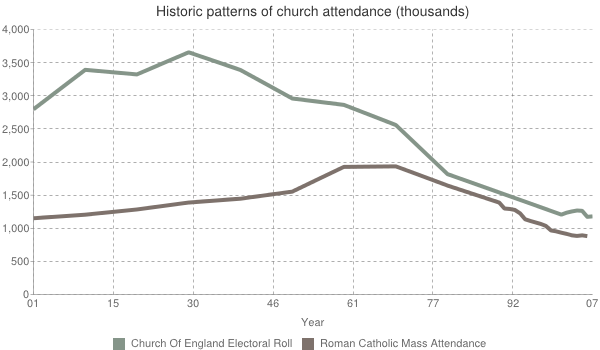
Similarly, the Church of England statistics office used to rely on estimates of 'usual Sunday attendance' to monitor trends in the church. Lynda Barley, Head of Research and Statistics for the Archbishops’ Council, lead a major review of church statistics to create a measure that was more robust and better suited to church and society in the new millenium. This was launched in 2000.
Measurments are usually based around a four week period in October each year when churches count all their worship activity, including mid-week and weekend worship outside of the ususal Sunday morning.
Church attendance statistics
Figures collected using the new methodology are now available from 2001 to 2008. The chart below show average weekly and average monthly attendence for Church of England. The numbers have been remarkably steady for several years now.
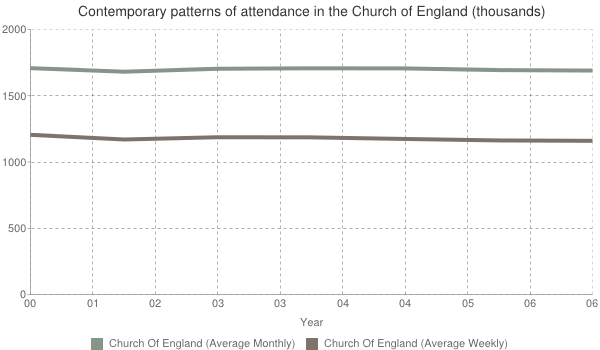
On average 1.1 million people attended church-based services of worship each week in 2008, slightly under one million of these on Sundays - the church is increasingly becoming 7 days a week, and not just for Sundays.
Numbers fluctuated week by week, among adults on average doubling at points across the month while almost quadrupling among children and young people. This is a trend we are following, and again it shows the changing nature of churchgoing. The changes in church and society are showing that increasing proportions attend church perhaps two or three times each month, rather than every week. Either because they are unwilling or unable to attend more regularly.
The statistics also show that young people and children are attending church and church related activities in growing numbers. This is good news for the future of the church.
Occassional offices
390,900 occasional offices performed by CofE ministers in 2008, with funerals making up nearly half of these. Although the overall figure for funerals is declining, the CofE still holds a service for nearly 4 in 10 of the deaths in England.
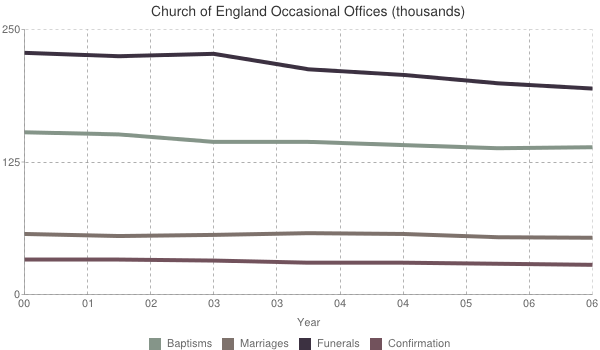
Baptisms and thanksgivings represented over a third of the occasional offices in 2008, marriages and blessings of civil marriages about one in seven.
In 2009, 56% of adults in Britain attended a religious service for a funeral, 44% to celebrate a wedding and 36% a baptism/christening (ORB Survey 2009).
Church of England and clergy
The Church of England has around 8,250 staff (full time equivalent), and is expecting to lose around 600 of those between 2009 and 2013. However, dioceses benefit from a growing number of Accredited lay ministers and retired clergy. Lay ministers serve as pastoral care workers, counsellors and educators and in many other ways.
Among those licensed as unpaid ministers attached to parishes, the number of self-supporting ministers (including ordained local ministers) stood at 3,100 in 2009, an increase of nearly 50% between 2000 and 2009. Across the country the number of Licensed Readers has decreased by almost 14% over the same period. In 2009 there were 7,472 licensed readers.
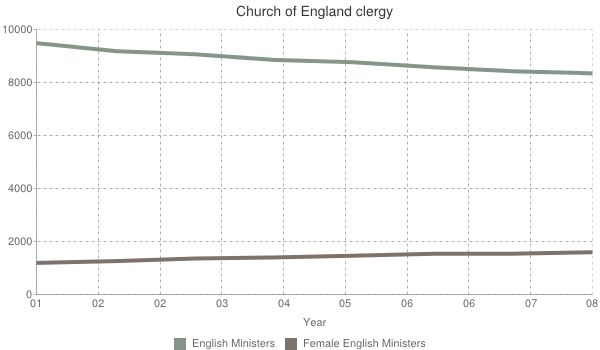
Women clergy
The number of women clergy, stipendiary and non-stipendiary, continues to rise. In 2009 there were 1,649 women in full-time stipendiary diocesan appointments compared with 1,466 in 2005 and 1,140 in 2000. Women make up one in five (20%) of stipendiary parochial clergy. Out of every eight incumbents one is a woman (13%). The equivalent figure including clergy of incumbent status is more than one in five clergy (17%). Of a total of 358 dignitaries in 2009, 32 were women, nine more than 2005 and twenty more than 2000. Women in self-supporting ministry in 2009 made up over half (51%) of the total. For Licensed Readers the equivalent proportion 49%. Licensed Lay Readers are trained but unordained people who bring their gifts of voluntary service to teaching, preaching, leading worship and pastoral care.
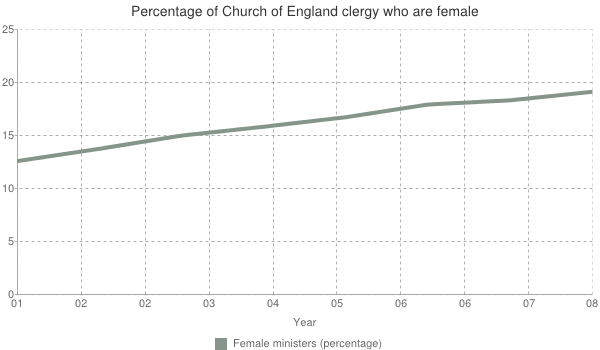
Relationship between Anglican Congregations and Ministers
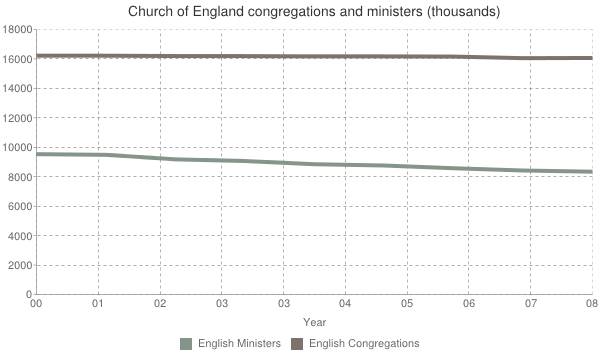
Average age of clergy
The average age of full-time stipendiary diocesan clergy is 51 years and one in five (22%) of full-time stipendiary diocesan clergy are aged 60 and over. Two-thirds (66%) are aged between 40 and 59 years, and 12% under 40. The average age of self-supporting diocesan clergy is 58 years while half (50%) of self-supporting ministers (including OLM’s) and 51% licensed readers are aged 60 and over. The majority of the remaining half are in the 40 to 59 age group leaving just 3% of self-supporting ministers and less than 3% of readers under 40.
Licenced ministry and ordination
Since 1994 when all categories of licensed parish ministry were opened to men and women, the total number of those entering licensed ministry in the Church of England has fallen by 10% from 1038 to 922 in 2009. Over the same period, the total number of ordinations has risen by 39% from 405 in 1994 to 564 in 2009 while the number of reader admissions correspondingly decreased by 43% from 633 in 1994 to 358 in 2009. In particular, the number of people ordained to stipendiary ministry has remained similar at 316 in 1994 and 309 in 2009 compared with approaching a three-fold increase in non-stipendiary ordinations (89 in 1994 to 255 in 2009). In addition, it is worth noting that just over half (55%) of those ordained in 2009 entered stipendiary ministry compared to 48% in 2007 and over three quarters (78%) in 1994.
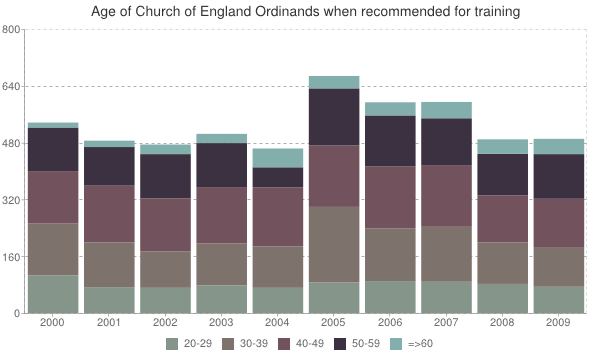
The total number of recommendations for training for ministry was 491 in 2009, 104 less than in 2007 and with 286 (58%) under 40 years of age. The number of readers in training has fallen by approaching a third (30%) since 2000 from 1,315 to 926 in 2009.
Church of England parochial finance
Financial giving
In the autumn of 2008, the "Credit Crunch" hit the UK economy. For many in the charitable sector, there was an immediate and significant financial impact. However, thanks to the commitment of church givers, 2008 parish incomes managed to increase when compared with the previous year, to £925 million. A 1.3% increase in donor income was the smallest percentage increase for many years, but this should be seen positively, given the wider economic picture and the downturn seen in the wider charitable sector.
Regular, planned giving continues to be the core of church finances. In 2008, parishes received over £296 million from 628,000 givers (or more precisely giving units where some will represent two donors) at an average of £9.06 per week. Most of these givers are able to give through Gift Aid, and over £80 million was reclaimed by parishes from HMRC.
Income received by parishes in 2008 from legacies reached record levels. The size of the average gift has increased, and it should be noted that the number of legacies for 2007 and 2008 appears low due to a change in the data collection questionnaire in 2007. This now asks for each legacy to be recorded only once, even if income is received in more than one financial year.
Outward giving from PCCs to mission organizations and other charities was £52 million, a very significant contribution to wider mission and charitable work.
Church of England key statistics
Church attendance and visits
- 1.7 million people take part in a Church of England service each month, a level that has been maintained since the turn of the millennium. Approximately one million participate each Sunday.
- Approaching 3 million people participate in a Church of England service on Christmas Day or Christmas Eve. Thirty-five per cent of the population attend a Christmas service of some sort, rising to 42 per cent in London, nationally, and 22 per cent among those of non-Christian faiths.
- The Church of England has the largest following of any denomination or faith in Britain today. More than 4 in 10 in England regard themselves as belonging to the Church of England, while 6 or 7 in 10 (depending on the survey!) consider themselves Christian.
- People attend their local churches in many different ways at different points in their lives. Each year 3 in 10 attend regular Sunday worship and more than 4 in 10 attend a wedding in their local church, while still more attend a funeral there
- In 2009, 43 per cent of adults attended a church or place of worship for a memorial service for someone who had died and 17 per cent were seeking a quiet space. Both these proportions are increases on 22 per cent and 12 per cent respectively in 2001.
- 85 per cent of the population visit a church or place of worship in the course of a year, for reasons ranging from participating in worship to attending social events or simply wanting a quiet space.
- Every year, around 12 million people visit Church of England cathedrals, including 300,000 pupils on school visits. Three of England's top five historic 'visitor attractions' are York Minster, Canterbury Cathedral and Westminster Abbey.
Education
- Seven in ten (72%) of the population agree that Church of England schools help young people to grow into responsible members of society and 8 in 10 (80%) agree that they promote good behaviour and positive attitudes. Latest available statistics indicate one in four primary schools and one in 16 secondary schools in England are Church of England schools. Approaching one million pupils are educated in more than 4,700 Church of England schools.At the end of 2008, there were 20,034 ministers licensed by Church of England dioceses, including clergy, readers and Church Army officers: one minister for every 2,500 people in England. The total does not include almost 1,600 chaplains to prisons, hospitals, the armed forces and in education, nor around 7,120 retired ministers with permission to officiate.
Church buildings
- There are 14,500 places of worship in England listed for their special architectural or historic interest, 85% of which belong to and are maintained by the Church of England.
- The Church of England has more than 16,000 churches, serving every inch of the country and open to every local inhabitant. There are 42 mainland cathedrals, plus one in Peel on the Isle of Man and the Diocese in Europe’s cathedral in Gibraltar.
- Three church and cathedral locations are World Heritage Sites: Durham Castle and Cathedral, Canterbury Cathedral, St Augustine's Abbey & St Martin's Church, and Westminster Abbey and St Margaret’s Church.
- In 2006, necessary repairs to all listed places of worship in England were valued at £925m over the next five years, or £185m a year. Around £110 million is currently spent on repairs to Church of England churches per annum, 70% of it raised by the congregations and local community.
- TThe Church recommended 490 future clergy for ordination training in 2008, maintaining the level at the turn of the millennium. It ordained 574 new clergy in 2008, the highest number since the year 2000. Overall, 274 women and 300 men were ordained in 2008, with more than half ordained to full-time, stipendiary ministry: 197 men and 124 women.
Community involvement
- A quarter of regular Anglican churchgoers are involved in voluntary community service outside the church.
- The Church of England provides activities outside church worship in the local community for 407,000 children and young people (aged under 16 years) and 32,900 young people (aged 16 to 25 years). More than 116,000 volunteers and an additional 4900 employed adults run children/young people activity groups sponsored by the Church of England outside church worship.
- Church of England congregations give more than £51.7 million each year to other charities - more than the BBC's annual Children in Need appeal.
Anglican - Devolved Nations
Devolved Anglicans - a definition
Anglican is a collective name for all denominations in communion with the Church of England, or derived historically from that tradition. In the devolved nations of the UK, Anglicans largely belong to the Church in Wales, the Scottish Episcopal Church or the Church in Ireland.
Anglican ministers in the United Kingdom
{plotalot id="24"}
[Please note: the Christian Research team has an outstanding query with the Scottish Episcopal Church about the numbers of Scottish ministers, and has presently estimated the number of ministers between 2007 and 2009]
Back